
Two hundred puzzles, fifty hours later by CJ Q. '23
mystery hunt, mystery hunt! puzzles puzzles puzzles!
This post contains minor spoilers for the structure of MIT Mystery Hunt 2020, which are unmarked. This post will contain major spoilers for some puzzles, which will be marked. This paragraph is not a puzzle.
I have no idea how this post ended up being even longer than my Splash post. I’m not sure what people think about this. Do people actually read the whole thing? Should I strive to make my posts shorter? Please let me know; I’m interested.
Anyway, here’s the contents. If you’re not interested in reading about puzzles, feel free to skip any sections that talk about puzzles, like On puzzles above and below. There’s a lot of non-puzzle content in this post too.
- Worthwhile puzzlehunt information
- Hunt begins here
- One puzzle down and more to go
- On puzzles above and below
- Searching for something new
- Help me because I don’t know
Worthwhile puzzlehunt information
What is a puzzlehunt?
The MIT Mystery Hunt is a puzzlehunt, the biggest and grandest of its kind. There are lots of ways to view Mystery Hunt. I gave a brief overview in my last post. It’s an event that happens the weekend before Martin Luther King Jr. day, with dozens of teams and thousands of contestants solving hundreds of puzzles.
One way to view the Hunt is from a technical perspective. I’ll give another brief overview of how puzzlehunts works here with the Mystery Hunt in mind. The following discussion is pretty general, but there are lots of exceptions. Brian01 I’m going to break blog convention here and use only the first name of everyone I mention, because I don’t really know everyone’s last initials or graduation years. wrote a more detailed introduction to puzzlehunts if you’re interested in learning more about puzzlehunts and how to solve puzzles in general.
A puzzlehunt is a series of puzzles, but what exactly a puzzle is is kind of hard to define. It’s like a Sudoku or a crossword, but you have to figure out the rules in order to do it. Puzzles have some sort of answer, which is usually a word or a phrase, like “COLLAPSE” or “FILM REVIEW”.02 When discussing puzzles, we write answers in capital letters to indicate it's an answer. Solving a puzzle will unlock even more puzzles.
Puzzlehunts have special kinds of puzzles called metapuzzles, or simply metas. After solving several puzzles, you get a series of answers. A meta is a kind of puzzle that uses these answers in order to find a new answer. For example, if you have the answers “FILM REVIEW”, “BACKGROUND NOISE”, “ADAMS APPLE”, “DEAD WEIGHT”, “COMPUTER SCIENCE”, and “EVIL EYE”, you can combine them03 Exercise left for the reader. As a hint, read the first letters. It’s often a good idea to read the first letters! to get the answer “ANSWER”.
A large puzzlehunt like the Mystery Hunt typically consists of several rounds, each with several metas, each combining the answers of several puzzles. Often, these metas are also combined to form an answer to a metametapuzzle, or a metameta. After a team solves the metameta, the Mystery Hunt then ends with a final puzzle called a runaround, which involves going around campus to find the location of a hidden coin.
The winning team then writes the Mystery Hunt the next year. Team Left Out won the 2019 Mystery Hunt, so they wrote this year’s Hunt. This is both considered a huge honor and a huge responsibility. It’s been joked that a team that might have otherwise won could choose to just not take the coin, because they wouldn’t want to write hundreds of puzzles, and organize an event for thousands of people. To my knowledge, though, I don’t think this has happened yet.
Here’s a diagram I made to summarize the (usual) hunt structure of the Mystery Hunt:
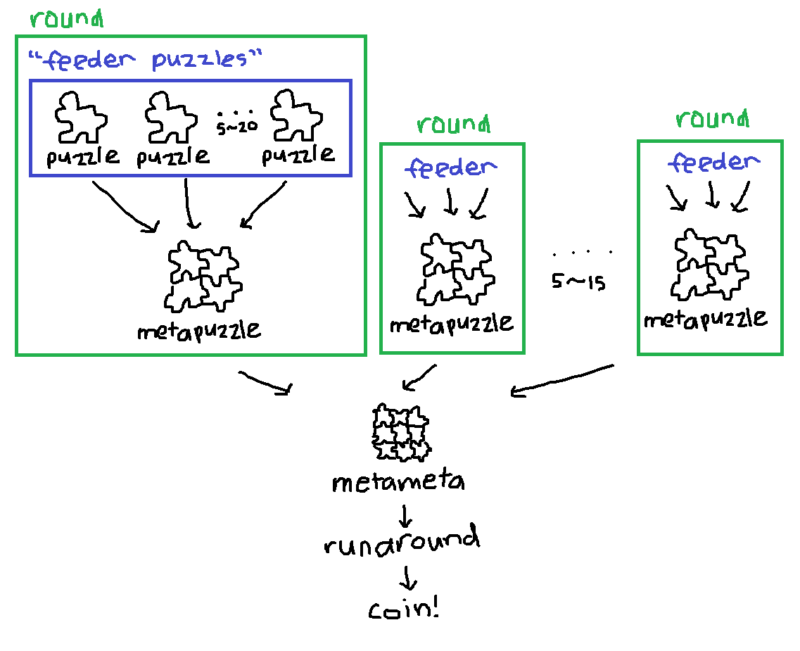
i can make diagrams in paint
All of what I’ve previously written should actually be prefaced with “usually”. Usually a puzzle doesn’t have instructions. Usually there are metametas. Usually there is a final runaround. Usually the hidden thing is a coin-like object. All of these rules can be subverted, and often a Mystery Hunt will subvert something, in one way or another.
Mystery Hunt teams
But the cool thing about Mystery Hunt is that we can look at it from a non-technical perspective, and I think this is where it gets interesting. One of the best things about Mystery Hunt is that there’s a very human face to it. The first thing you ask someone who hunts is what team they’re in, because so much of Hunt experience is shaped by who you hunt with, and you learn things about people based on what team they’re in.
While Hunt’s been around for around forty years, the oldest teams I know of04 This entire section is not very well-researched, so read everything with an “I know of”. Also, the easiest way to learn something on the internet is to be wrong and wait for someone to correct you. Please correct me. trace their roots to around twenty or so years ago. Some of these are teams like Palindrome, Setec Astronomy and Manic Sages. Each of these are rather large teams with anywhere from 70 to 200 people, with most members being hunt veterans in their 30s or 40s. These teams have been hunting for a long time, and the three teams I’ve mentioned have won the Hunt at least once.
I don’t know much about the history of any of these teams, other than they’ve been around for a long time. Quick research shows Manic Sages was formed from Mathcampers and ESG in 2004. Palindrome and Setec have been around since at least 2000. I also think Sages dissolved around five years ago, and some members formed Rage, and maybe other splinters.
Some other teams that have been around for a long time include Death and Mayhem, Codex, Left Out and Luck. Death and Mayhem is another large team with around 70 members, merged from two teams several years ago. I don’t know how long they’ve been around; my best guess is seven or eight years ago, with the two source teams being even older than that. I’m also not sure, but I think Codex, Left Out, and Luck have been around for at least a decade, are mid-sized teams with around 30 to 70 people and have won the hunt at least once.
Mentioning these teams can give the impression that the Hunt is just about winning. While it’s true that there are Hunt teams who want to win, from my understanding, all of these teams are still friends who meet up once a year to solve puzzles and have fun. In a sense, then, Mystery Hunt can function as one big alumni reunion.
But I also don’t want to give the impression that the only people who join Mystery Hunt are alumni, or are competitive teams. For example, the Association of Taiwanese Students has a huge team called Super Team Awesome. They originated in 2007 and have more than a hundred people, with members that include both current students and alumni. There’s also Math Campers Solve Puzzles, a Mathcamp team that only formed two or three years ago,05 I don’t really know, and none of the people I asked knew either. and only has around a dozen people.
Several teams I know are associated with living groups. WaffleHaüs is the Simmons team, and I know Macgregor has teams based on entries. Three big Random teams I know are, from oldest to youngest, Metaphysical Plant, Hunches in Bunches, and Random. Plant and Hunches are mostly alumni, while Random has a lot of current students. Next has NES, a team with around twenty people that only formed this year,06 I think before this year, most people who hunted from Next were associated with Super Team Awesome, though I may be wrong. It may even still be the case this year. and also a bunch of individual floor teams.
East Campus has Putzazoo,07 Wayne, who read a draft, complained: “Putzazoo? I thought we called them Tetaputz.” which originated from Tetazoo, then later Putz, then later First East,08 Each of these are names of floors. Tetazoo is Third East, Putz is Second West, and First East is… First East… and now is just a big East Campus team. Epsilon Theta has ET Phone In Answer, which I don’t know much about.
Although I say Luck, Random, Putzazoo, or Codex, these are all teams that change their name often. I know Luck was Beginner’s Luck and Luck, I Am Your Father, Random was One Fish Two Fish Random Fish Blue Fish,09 Lillian and Cesium point out that this team split into the Random team and <em>Hunches in Bunches</em>. and Codex picks random codices as names. These three teams consistently put the word Luck, Random, or Codex in the team name to make them identifiable. But Putzazoo has no such convention; this year I think they were United States Census, and several years ago, they was also named [the entire text of Atlas Shrugged]:
![a screenshot of the 2014 hunt website, “the writing team’s previous name of [the entire text of Atlas Shrugged]” is highlighted](https://mitadmissions.org/wp-content/uploads/2020/02/100.jpg)
taken from the 2014 mystery hunt website
✈✈✈ Galactic Trendsetters ✈✈✈
And this brings me to my team.
I’ve talked about Floor Pi before, which is the floor of East Campus I live on. We like many things, and one thing that Floor Pi likes a lot are puzzles. We like them enough that we have our own big Mystery Hunt team, called ✈✈✈ Galactic Trendsetters ✈✈✈.
The first ✈✈✈ is read as whoosh, while the last ✈✈✈ is read as neowww.13 While everyone spells the first plane noise as <em>whoosh</em>, there is considerable controversy as to how the other plane noise should be spelled. And I think this is the correct way to spell it. One of our team’s traditions is that when someone says the first part, whoosh, Galactic Trendsetters, everyone within earshot responds with neowwwwwww. It’s very fun.
The team is named after the Race for the Galaxy card named Galactic Trendsetters, which is supposedly a good card, although I’ve never played the game. Danny tells me that Floor Pi had a Mystery Hunt team at least as early as 2009, when the team was named Low Latent Inhibition. We gained our current name in 2013.

this art is hilarious and i don’t know why
Historically the team had 20 to 40 people, but recently we’ve had more like 80 to 100, who were increasingly generalized residents of Floor Pi. At one point, we were large enough that a team called teammate, a mix of people from CMU and Berkeley, branched out from us into their own team. Galactic and teammate have been sister teams ever since.
The majority of Galactic and teammate members are around the ages of 18 to 30. We’re pretty similar culture-wise, in that we lean towards younger members and are heavy on memes. The two teams considered merging before Mystery Hunt this year, but ultimately decided against it because it would put our team size way above the recommended upper limit.
Alright, enough of the history lesson. How did I end up hunting with Galactic?
I mean, the story isn’t that exciting. Julian, one of the Floor Pi hall chairs sent out an email last October with a pre-hunt survey introducing Galactic. I signed up. Come November, I got added to the Discord server for Mystery Hunt 2020. We started discussion pretty early, having a logistics meeting mid-November about recruitment, tech, management, food, and other pre-hunt stuff. I signed up to design nametags during the meeting, which Lilly helped print out, and they turned out quite well:
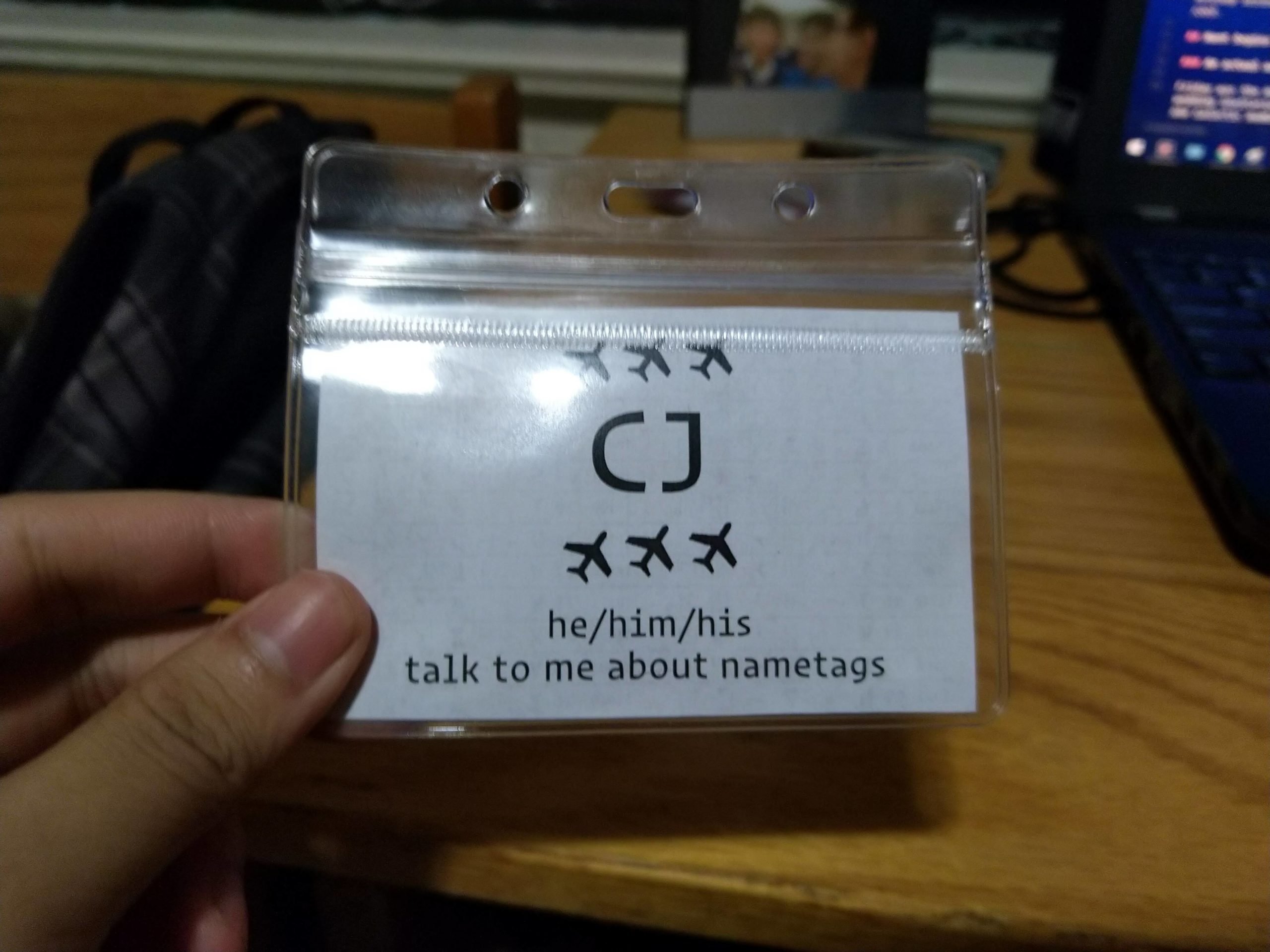
front
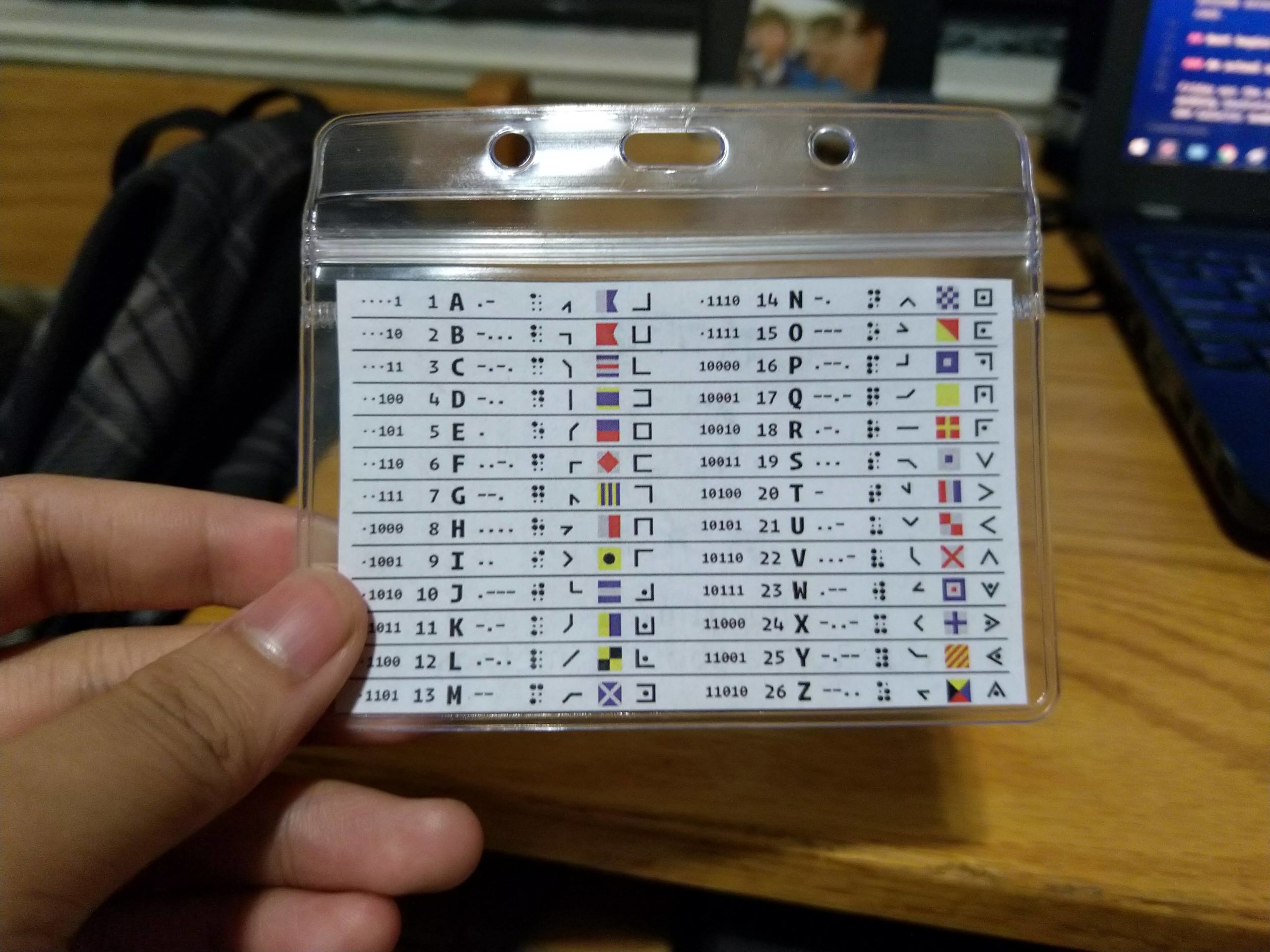
back
And so November and December came and went, and soon enough it was mid-January and hunt was going to start soon. A bunch of Galactic members flew into Boston, while some were already in the area. There were lots of alumni around Floor Pi the week leading up to Mystery Hunt. It culminated on Thursday, the night before the hunt, where there was a Galactic board game night for people who’ve already arrived, and I got to play a lot of games with people, which was pretty cool.
Hunt begins here
Kickoff
Friday was the Hunt kickoff, which happened in Kresge at noon. Teams were sent wedding invitations a couple of days before for the wedding of “M & G”, which one Galactic member pointed out was similar to the wedding invitations sent out to teams in 2011:
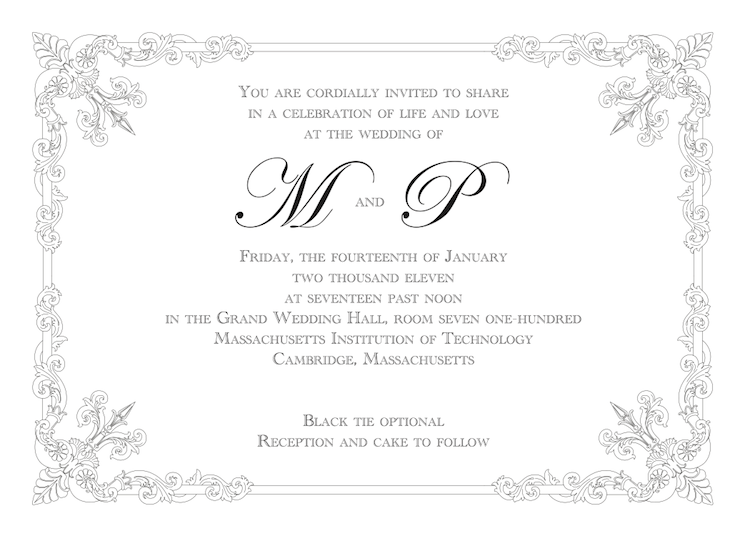
the 2011 invite sent out to teams

the 2020 invite sent to teams
Of course, as is tradition, the Hunt wasn’t actually themed around the wedding. In 2011, the letters M & P stood for Mario and Peach, and the hunt was themed around video games. Often, there’s a fake theme that is quickly replaced by the actual theme, which is revealed in the kickoff.
But that didn’t stop the wedding from being real. Yep, that’s right. It was a wedding invitation because the kickoff began with an actual wedding. You can watch the video of the kickoff here. The ceremonies begin around 2 minutes in:
The wedding was between Mark Gottlieb and Gaby Weidling, both game and puzzle designers. Apparently, Mark wrote one of the really old Mystery Hunts entirely on his own, back when it was much smaller. During the ceremonies, we found out that time-travelling ninjas stole an artifact known as the Cardiac Omniscient Interdimensional Nexus (COIN) and hid it somewhere in the MIT campus, giving puzzles leading to the COIN’s location. Oh no! It’s then quickly found by Gaby, and then the real theme of the hunt is revealed. If you haven’t, you should watch the intro; it’s funny and sweet.
The hunt is actually themed around saving a dying theme park. Here’s the promotional video shown to us in the beginning of the hunt:
The park is dying due to a lack of popularity, and us puzzlers were tasked to help save the park by generating buzz, which apparently can be done through solving puzzles.14 Yeah, I don’t get this part either. And with that, we were given the hunt website, pennypark.fun, got a safety orientation, and were told that the puzzles would get released at 1:30 PM.
We head back to the two classrooms assigned to Galactic for the weekend, and have a short meeting about logistics. It was a brief introduction to our tech, people in charge of various things, and some reminders. After the meeting, I also picked up a really sweet shirt, which Jakob helped order:
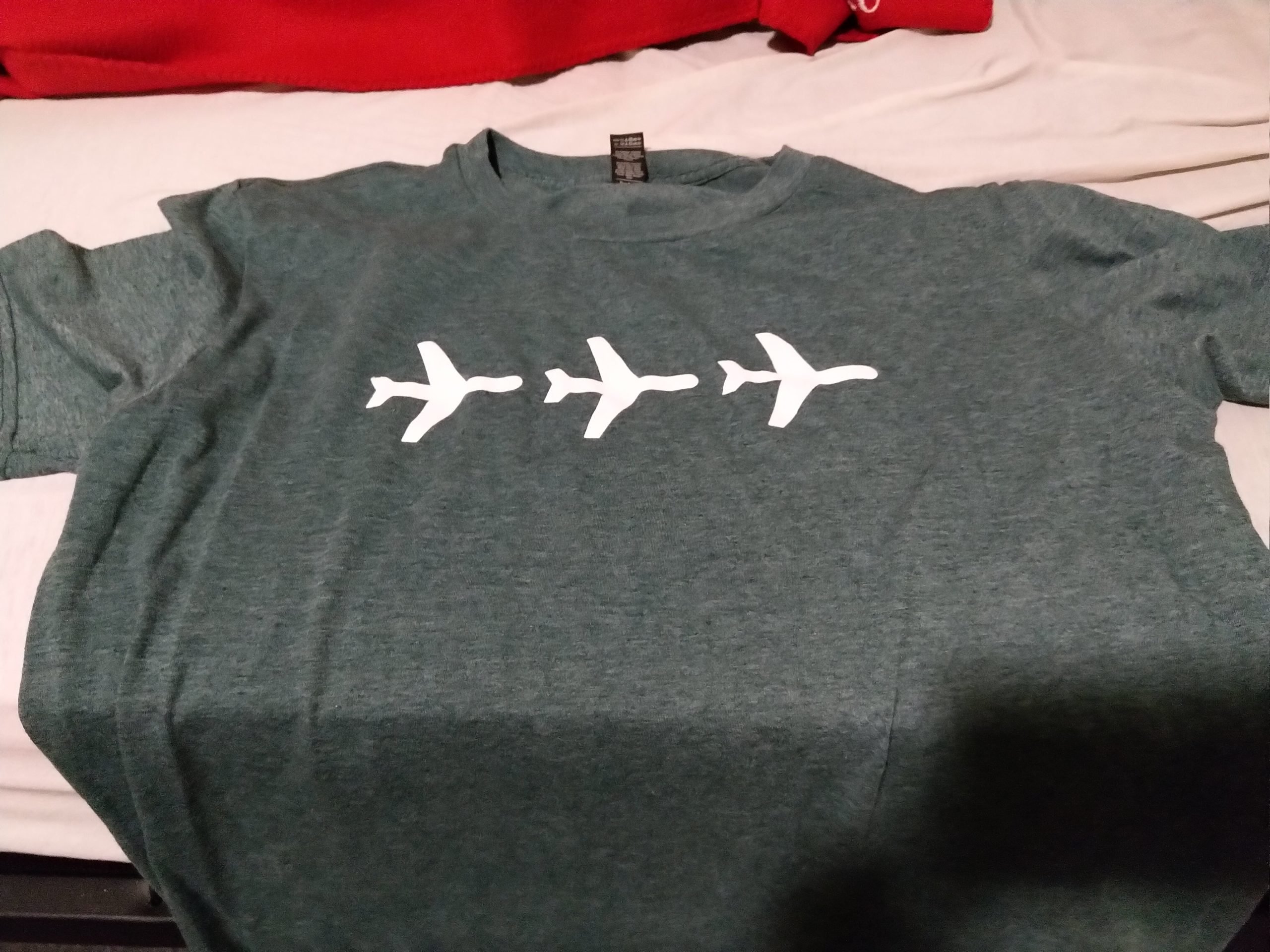
there were like six choices for the colors of shirts. this is in fact jeffery’s shirt and not mine because mine was brown
The first puzzle
After the meeting ended, the website opened, and I started looking at the puzzles available to us. Initially, we were opened to a few puzzles in Storybook Forest and The Grand Castle. The puzzle I tried first was Penny Park Guide, which I started working on as soon as we received copies of the brochure.
I worked on it for a little bit, helping collect data from the brochure, but not really providing any of the ahas, or the insights needed to solve the puzzle. After that, it was just before 2 PM, so I decided to go to the lecture of one of the classes I’m taking this semester, 6.S087 Mathematical Methods for Multidimensional Statistics. During lecture, though, I found my attention divided between the lecture and the Hunt. Let me explain why.
Galactic is a pretty big team, with a lot of remote solvers, which are people who aren’t solving in MIT with us. Because we’re a big team, coordination is pretty important. The way Galactic coordinated this year’s solving is through Galackboard, which Rob, Nathan, Jason, and a bunch of other people helped build. It’s a website built on the Codex Blackboard. I wish I had a screenshot to show you, but I don’t, so have this poor drawing instead:

more diagrams in paint
The way it works is that it makes a Google Sheet, from a template, in a Google Drive for each puzzle. When you click on a puzzle, it brings up the spreadsheet and a persistent puzzle-specific chat on the right. So at a base level, Galackboard acts as an easy way to access several spreadsheets, and a way to view the previous messages people have sent about the puzzle.

more diagrams made in paint
It also allows you to add tags and set the status of a puzzle, which also turned out to be really helpful. The status shows up on the main screen, so you can look at the list of puzzles and view how far people are in solving it, and where their physical location is, if any. Puzzles can also be tagged with categories like “logic puzzle” or “pop culture”, and this will notify people who are interested in solving puzzles with these tags. Puzzles can also be marked as stuck, which will color it red in the main screen, and as solved, which will mark it green.
In addition to the livestream and the voice chat, I thought this actually made the remote solving experience tenable. It also just made our solving way more organized, which was a huge part of my hunt experience. Despite not being in the same room as people solving the puzzle, I still felt like I could actually contribute.
Of course, because my attention was divided between paying attention to the lecture and watching people’s progress on the puzzle, I again didn’t feel like I contributed a lot. After a couple minutes, I stopped following Galackboard and started paying attention to the lecture.
One puzzle down and more to go
Even more puzzles
This subsection has spoilers for the puzzle Magic 8-Ball. It only really talks about that puzzle and nothing else, so feel free to skip this subsection if you’re not interested in reading about the actual puzzles.
When I came back from class, I learned that we had already solved our first meta, which was Storybook Pals. I think solving this meta unlocked the next location, which was Spaceopolis.
The other thing I learned was that people were making progress on Penny Park Guide, but still haven’t solved it. They’ve gotten to the point where they have all these instructions and are figuring out what to do next. I decided to work on a different puzzle instead.
I looked briefly at Stress Test, a puzzle in Spaceopolis. But it looked like people were almost finished solving the puzzle. Solving that puzzle unlocked another puzzle—Magic 8-Ball, in a new area, Wizard’s Hollow. So I got to work:

yep, we had to cut and fold and paste these
I saw through this puzzle from the beginning to the end, so I’ll explain how it was solved here, as a good example of what solving a puzzle is like.
Reading the text in the beginning of the puzzle hints at putting together the triangular pieces to construct something, from this one requires a bit of assembly. The first instinct was to match up the 8s that were the same, and put them on top of each other in some way. At first, we thought there were three or four copies of each of the different styles of 8s.

exactly two of the four are the same and everything else is different
But we soon noticed that they were actually different, in extremely subtle ways, and that there were only two copies of each 8. As the puzzle text hinted, an eye for detail was needed.
While my roommate Jeffery, who was hunting with us, printed and cut the pieces, I think it was Rob, Laura, and I who were pairing the 8s up and gluing them together. Since there were twenty pieces, we guessed that the finished shape would be an icosahedron. It was a bit of a timesink to match the 8s up together, and a couple of times I had to pull out Photoshop and overlay 8s to make sure they were identical, but in the end, we formed this beautiful polyhedron:
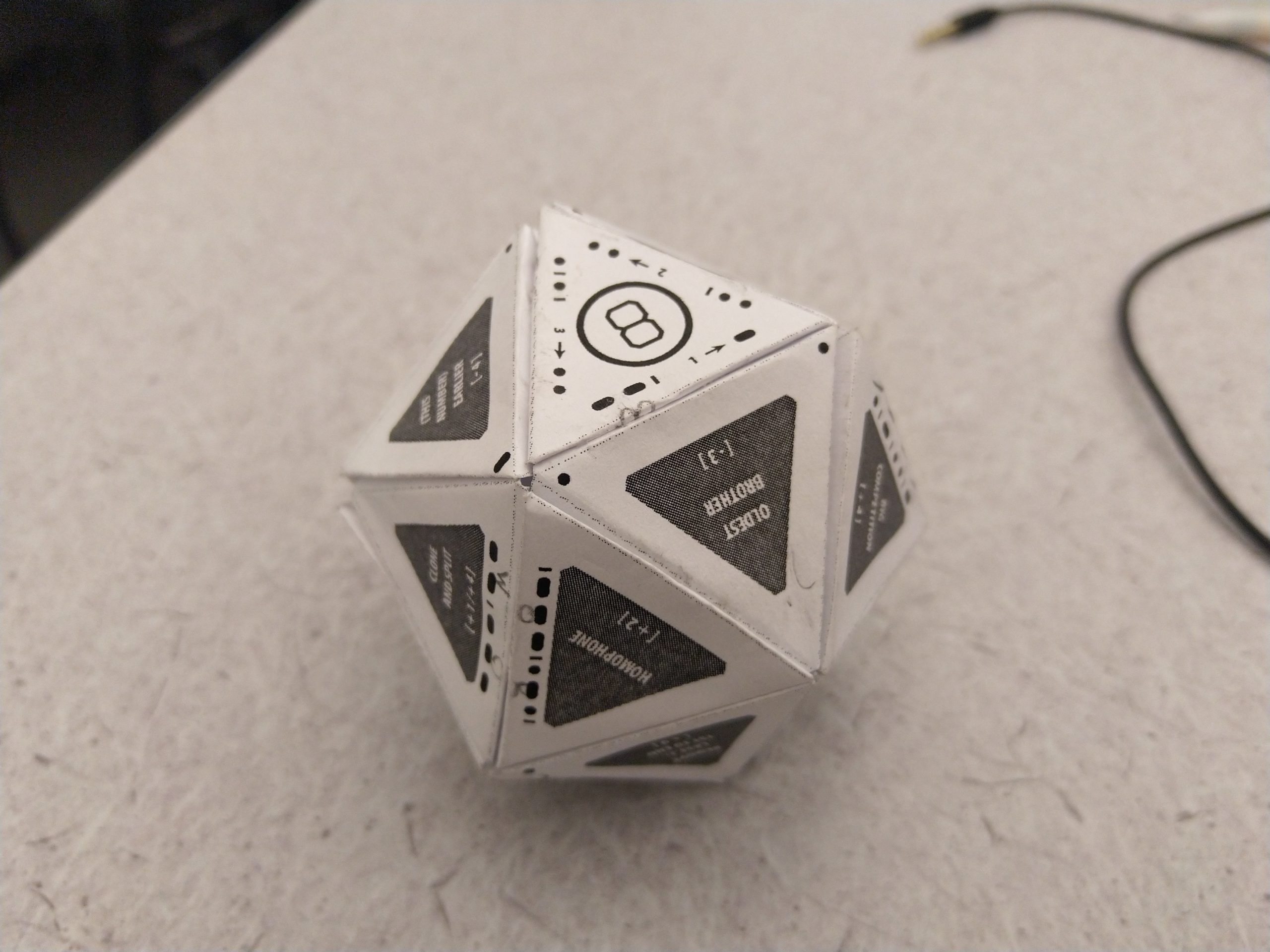
i got to keep our assembled icosahedron
The next step was to do something about the Morse code that went around the icosahedron. We correctly interpreted it as reading it starting from the 8 face and going around, interpreting the vertical bars as letter dividers. Then Rob, or at least, I think it was Rob, knew Morse code by heart and started decoding. This gave us the good phrases “CHESSEX D20”, “START AT 1 WITH” and “SORCERERS STONE”. Except for a long while, we didn’t read the final 0, so we thought the first phrase was “CHESS EXD2” and were very confused, trying a lot of different things that didn’t work out.
Chessex, apparently, was a brand that sold D20s, which are dice with 20 sides. By searching up pictures of Chessex dice on Google, we were able to map the 20 sides of the D20 onto the sides of the icosahedron.

observe how the 8 is oriented the same way in both pictures. right photo from amazon
We then took note of what happened when you took these numbers and added it to the number on the bottom of that face. For example, the face with “=4TH STUDIO ALBUM” was face number 12 and had [+6] at the bottom, so we took note of 12+6, or 18.
There was a nice pattern—it almost had all of the numbers from 1 to 20, except it didn’t have 1 and it had two 13s. And then someone, Patrick, I think, came up with the idea of starting with the instructions on face 1 with the phrase Sorcerer’s Stone, and then following it to the next face.
For example, the instruction on the first face was “3 ITEMS LATER”, and 3 items later after Sorcerer’s Stone is Goblet of Fire. That face had [+1] at the bottom, so we went to the second face, which had the instruction “BIG COMPETITION”, and the big competition in Goblet of Fire is the Triwizard Tournament. Continuing like this gave the final answer, CORNUCOPIA.
Stuck on extraction
This subsection has spoilers for the puzzle Charming.
Many puzzles are kind of divided into two parts. Roughly, there’s a phase where you collect data, like doing all of the puzzles in Penny Park Guide, or making the icosahedron and reading the Morse code for Magic 8-Ball.
Then, there’s a phase where you use this data to find the final answer. Most people will call this latter phrase extraction. There are lots of ways to extract the final answer, like checking the first letters of everything to see if they spell a phrase, or if you have a list of answers and numbers, indexing into each answer to get a letter.
Often these two phases feel distinct. So it’s somewhat common for a group of solvers to have all the data, and then get stuck on extraction. I’ve identified all of these places, but now what? I’ve filled out all of these crosswords, and then what?
That’s where we were stuck on after working on the puzzle Charming. After a quick inspection of the puzzle, we feel each clue has two parts. For example, Charms 101, which says “In this course you will learn the subtle art of sending your colleague flying backwards if he tries to put marinara sauce on soba,” clues two things: “sending your colleage flying backwards” and “marinara sauce on soba”.
The first parts were all Harry Potter spells. For this one, it’s flipendo. The second part, which was the aha moment, was realizing it described a class from the 2010 MIT Charm School. This one was describing Pasta vs. Noodles. So we went through the list and identified all the charms and the classes, but then we couldn’t figure out what to do next—we were stuck on extraction.
I left shortly after getting stuck on Charming to work on our web.lab project. I came back later that night, a bit past 1 AM, to briefly check on how Hunt was going. When I arrived, people were already unlocked a new area, Big Top Carnival, and were working on the puzzle The Aerialist. After solving it, we unlocked a puzzle called Domino Maze, where we were given a whole copy of Domino Maze:
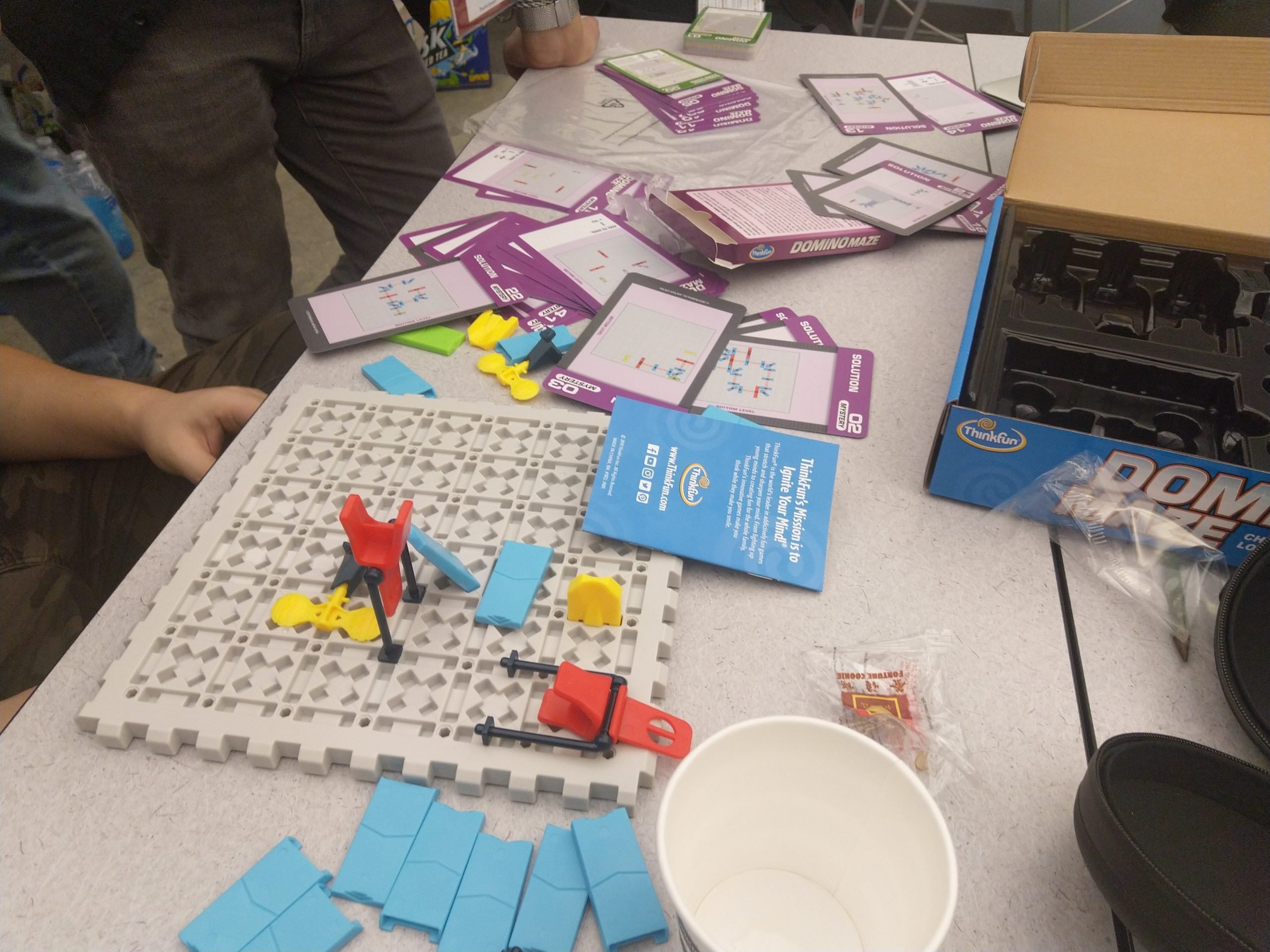
“is it okay if i take a picture” “only if you use it in a blog post”
Think about it. Left Out provided teams with an entire copy of this logic puzzle,15 This used to say board game, and then Brian disputed this, so I checked <a href="https://www.boardgamegeek.com/wiki/page/Game_Criteria">BoardGameGeek standards</a> and realized <em>logic puzzle</em> would be a better phrase. and gave us a 44-puzzle expansion pack, printed by the game’s manufacturer, that was meant for Mystery Hunt. That’s insane production value. But the puzzles in the expansion pack already had solutions to them on the back. And so it lead to the natural question: how were we going to extract an answer out of this puzzle?

but it already has a solution!!
I left that night a little past 2:30 AM with someone else from hall, and we talked a bit in the Floor Pi lounge before heading to sleep.
The robot parade
I woke up the next morning to find out that not only have we solved Domino Maze (which was incredible), but that we’ve finished all of the inner lands and have unlocked outer lands. The initial map that showed us only seven areas expanded to show four more areas in each corner. Our first outer land was Creative Pictures Studios, where, I was informed, the answers were all emoji.
I guess that’s what it feels to be hunting with a big team—you don’t really get to see a lot of the puzzles, you have to get updated with what happened if you’re away for some time, entire areas can get unlocked and solved when you’re gone. But it also feels as if we’re making progress together, in such a fast rate, and it also happens that a lot of my friends are on Galactic. Such is the tradeoff.
One of the things that happen during Hunt are events, which are just cool events that (usually) are linked to a puzzle of some sort. For example, one huge high-production value event was the Midway, which was a full fledged carnival midway! (All the information needed to solve the puzzle is on that page too.)
The team was looking for someone to volunteer for the Robot Parade. We were assigned to get someone to dress up as Angelyne. And if you’re a Zoomer like me, you might not know who Angelyne is. She’s a lesser-known robot from Futurama, who’s uh, very sexualized:

taken from futurama wiki
Jakob and Justine made my costume, which they did while I was thinking about the puzzle Sightseeing. I was standing in front of my laptop staring at the puzzle while they put boxes around my torso and checked my measurements. We talked a bit about Floor Pi and its history, which was pretty interesting—apparently, we could have been called Pi West as recently as 2008. They put a lot of work into making my beautiful costume:
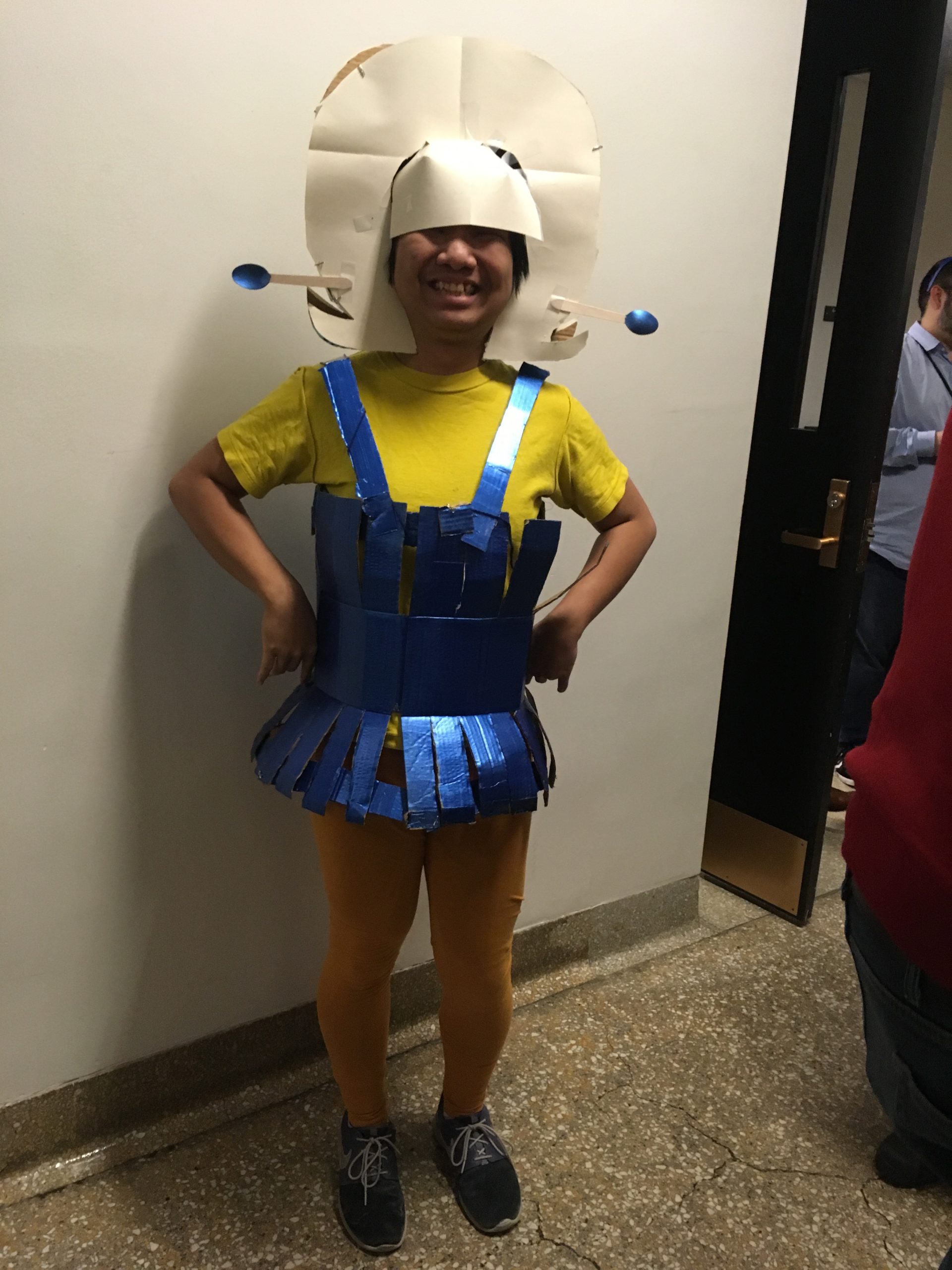
i could barely see with that hair
Come 2 PM or so, we gathered in a room to get our briefing for the parade. There were five different kinds of robots: Bender, Crushinator, Malfunctioning Eddie, Angelyne, and Calcutron. There were ten or so of us Angelynes standing in a corner, and we were given instructions on how to parade. We were to sing a song that consisted of a bunch of boops and beeps. And then we paraded!
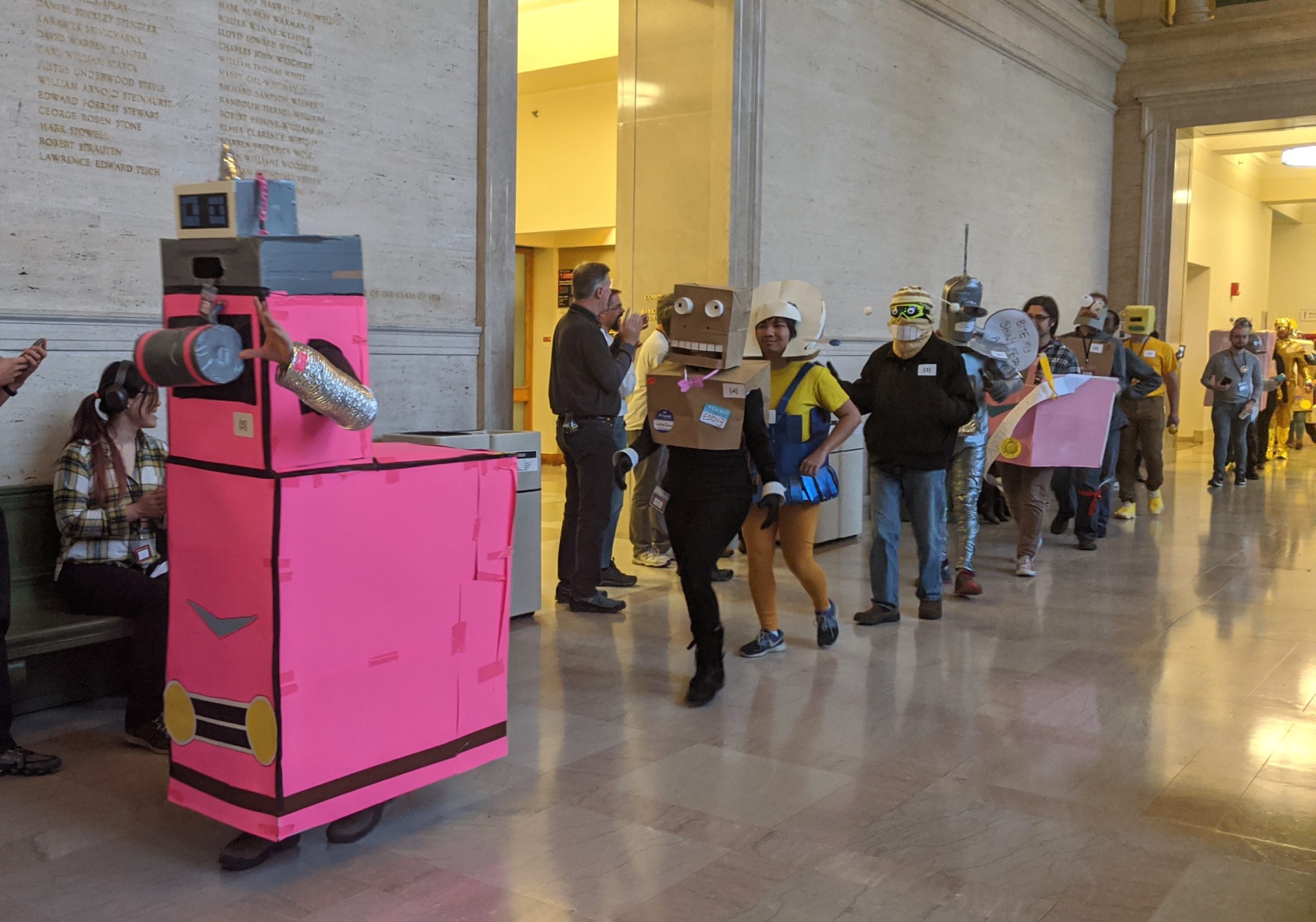
by shifting my hair up, i could now see
Lots of people came out to watch as I strode down the Infinite Corridor in my beautiful costume. The path went through the Infinite, into Lobby 10 where lots of people were watching, then turned around at Lobby 7 and went back. Left Out posted a video of the parade here, and it’s pretty hype:
Of course, the parade is still a puzzle. We were given a sheet of paper with the complete lyrics to the beep boop song, which we used to get the answer to the puzzle.
On puzzles above and below
This section contains spoilers for the puzzles Rabbit, “Tech’s Adventure” Walkthrough, Pay It Forward, Breakfast Menu, Old West Revue, Wild West Recipes, Tall Tales, and the Safari Adventure meta and submetas. It is entirely puzzles. If you only read one part, read Breakfast Menu.
From when I came back at around 4 PM after the Robot Parade, until I slept at 1 or 2 AM that night, I worked on nothing but puzzles. And I thought many of the puzzles I solved were rather nice. So think of this section as a love letter to Left Out, where I talk about all of the puzzles I enjoyed working on, and the little contributions16 Well, I <em>hope</em> I contributed, rather than, you know, anti-contributed. I made to help solving them.
Rabbit
Creative Pictures Studios represented an innovation in making the answers emoji, and the second outer land, Safari Adventure, represented another innovation in making the puzles have multiple answers.
The only Safari puzzle I really helped solving was Rabbit. I helped in filling in all the clues and answering them. Reading the first letters17 Always a good idea. down the left column gave “TAKE MOD TWENTY SIX”. Then the aha that led to the extraction step was realizing that the carrots should be read as carets, and realizing this led to our collective groaning, and this gave two different answers to the puzzle.
The other cool thing about Safari Adventure, other than the puzzles having multiple answers, was realizing that the puzzles fed into multiple metas. People realized this when two metas opened up that both used the same animal, but different answers of the same animal. The meta squad18 There are people on Galactic who <em>really like</em> working on metas. then estimated that there would be around nine metas, and that they fed into a metameta for Safari Adventure. So that’s the innovation for Safari Adventure: its puzzles went into multiple metas.
“Tech’s Adventure” Walkthrough
After Rabbit, the next puzzle I worked on was “Tech’s Adventure” Walkthrough. Several people were disappointed when the puzzle wasn’t an actual text adventure, because some people on our team really liked text adventures.
Initially, it looked like a runaround starting in some unspecified place in MIT, which we were supposed to figure out. We started drawing this huge map on a chalkboard, and used clues like “float through space for the length of one room” or “snuck into the back of the lecture hall” to try to figure out where it could be in MIT. The clues suggested a lecture hall that spanned two floors, but trying each of these lecture halls didn’t match up with the rest of the puzzle.
So we thought that it wasn’t actually MIT rooms, but something else. But what? We were stuck on this for so long that I worked on something else, and a few hours later someone realized that it was the four panels in Building 56, as clued by “The original versions of your game maps have been on display in the halls of MIT for over ten years, ever since they were installed in the 50s.” I’ll admit it: the puzzle tricked us.
Pay It Forward
The Mystery Hunt always includes a scavenger hunt of some kind, and this year’s hunt had Pay It Forward, a “scavenger hunt” where we did charitable tasks to earn points. For example, teams could get 4 points per each small bird house made, 10 points per each pet security blanket knitted, 1 point per two books donated, and so on. Galactic needed 95 points to complete the hunt, because our registered team size was 95. That was a lot.
Rob helped me film a video for the It Gets Better project, which is a collection of videos of people telling stories aimed at inspiring LGBTQ youth. I felt drawn to that task; the project was something I wish I knew about when I needed it. I also helped fold about fifty paper cranes, which provided a good distraction while thinking about Tech’s Adventure.
Breakfast Menu
If I had to pick one favorite puzzle throughout the hunt, it has to be Breakfast Menu. As soon as I heard someone say the words heraldry in the back of the room, I was instantly interested, and behold—there was a puzzle about heraldry!
In particular, the puzzle included blazons, which are formal ways to describe a coat of arms. They’re described in such a way that a reader can reconstruct the coat of arms, given just the blazon. Wikipedia gives the example of the arms of Östergötland, Sweden: Gules a griffin with dragon wings tail and tongue rampant or armed beaked langued and membered azure between four roses argent.
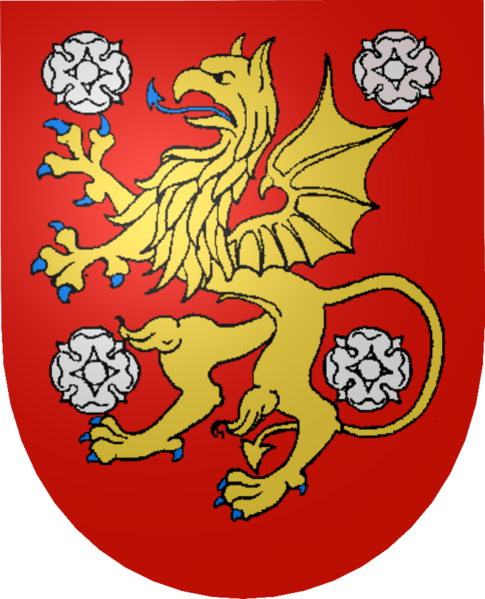
taken from wikipedia
The first word, gules, described the background of the shield, which is red. The next phrase is a griffin with dragon wings tail and tongue rampant or. This describes the main charge, a griffin, and its color, or, gold. The next phrase is armed beaked langued and membered azure, which meant certain parts of the griffin were azure, blue. Finally, between four roses argent described the four roses, and their color, argent, silver.
I was really into blazons when I was around fourteen, and spent all the free time I had for a month looking into them and how they worked. And finally, finally, the esoteric knowledge I’d built up through a streak of nerdiness in eighth grade paid off! Each of the blazons described a coat of arms that looked like this:

the first two blazons described in the problem
Lilly then made the connection that the Splashdown Diner logo looked like the Waffle House logo, and someone else realized that these were all codes Waffle House uses to communicate specific orders:

taken from this article
Describing the orders filled in the blanks, and the circled letters spelled out the answer, TELEGRAPH STATION. That puzzle felt really good. There’s nothing like using oddly specific knowledge to solve a puzzle.
Cactus Canyon
Cactus Canyon was the last of the outer lands. There wasn’t anything odd about the land, just that it had a lot of feeder puzzles. I thought that three of the puzzles I looked at were rather amusing, so I wanted to share them with you.
The first is Old West Revue, of which the data collection step consisted of reading a bunch of non-Latin scripts. I pinged one of my Thai friends to read the Thai script for me, who pointed out that it read something like this is my (house) I have to defend it. It didn’t read that in Thai, it read that in English—it was the English sentence written phonetically in the Thai script. So yeah, I thought it was pretty cool how I pinged my friend to help out with the puzzle.
The other one is Wild West Recipes, which is twenty-five videos of “recipes”. They range from seemingly normal ones like this, to crazier ones like this. They were pretty fun to watch and collect data for, which is a good thing for a puzzle that involves data collection.
And finally, there’s Tall Tales. Left Out got Oliver Smoot, yes, that Oliver Smoot, to read out the story for this puzzle. Here’s a video of him saying who he is.
Safari Adventure
The other thing that really excited me that night, other than the blazonry puzzle, was the Safari Adventure meta. It would turn out to be the only meta I helped solve throughout the entire hunt, which is totally fine, considering how I thought it was, by far, the best meta.
To recap, each of the puzzles in Safari Adventure had multiple answers, and the different answers fed into different submetas, which all fed into the Safari meta. When I jumped in to watch, the meta squad had solved seven out of the ten submetas they’d unlocked.
Each of the submetas required the answers to a subset of the animals in the round. The Trainer, for example, required the answers to the twelve animals in the Chinese Zodiac: Tiger, Rabbit, Dragon, and so on. Sam required the answers to five striped animals: Dragon, Snake, Hyena, Tiger, Zebra.
All of the submetas required a Tiger answer, but there wasn’t any Tiger puzzle. The aha was to realize that each of the Tiger answers were from William Blake’s poem The Tyger. And like the Safari Adventure meta suggested, the way to extract the meta answer was to take which lines of the poem the answer came from, and convert them into letters using A=1, B=2, and so on.
I helped with solving the Anne, The Captain, and Jack submetas, which led us to the meta answer. This then led us to an incredible chain of backsolving, which is one thing that Galactic loves.
Normally, we find the answer to a meta by using the answers from the puzzle, which is forward solving. But if you happened to answer the meta first, you could then use this to find the answers of the feeder puzzles, which is backsolving. All the metas in Safari Adventure were designed to be backsolvable, because you needed to find the answer for the Tiger puzzle, but this also helped us solve many other puzzles as well. So that was pretty cool.
Searching for something new
The last puzzle
This section contains spoilers for the Workshop metameta. Brian has a more exciting retelling of this on his blog.
After my puzzle solving spree that whole afternoon, stretching into the evening, I found myself thinking about Hunt. Not about puzzles, but about the Hunt itself. Why do it? What was the point?
Was it to socialize? It’s true that I did get to talk to some of the Floor Pi alumni, and I got to listen to a story or two, and I loved hearing about the history of the floor. But even when I had dinner that night, when I walked to Saloniki and back with some of the older team members, most of what we talked about were puzzles. We talked about good puzzles and cracked jokes about puzzles and mentioned previous years’ puzzles. And while that was good, it wasn’t exactly what I looked for.
So was it to solve puzzles? It’s not something that I could do alone; I enjoy solving puzzles with others way more than I enjoy solving them alone. But do I really enjoy puzzles if I don’t feel like I’m doing a major contribution? Are puzzles really fun if you’re just constantly stuck?
I went to sleep that night at around 1 AM, expecting to be woken up some time in the morning, when we reach the metameta. I was woken up around 5:30 AM, and was told that we had solved the Cactus Canyon meta and unlocked the metameta puzzle. I headed to Galactic HQ with some other people from Floor Pi who were sleeping.
After we solved each meta, we got pressed pennies. People went to the Workshop, where the Tinkerer took a penny and pressed a pattern on it. There were arrows on the border, as well as three pictures:

taken from this page; check it out for more cool pictures of pennies and how they were pressed
Inner lands provided us one pressed penny, and outer lands provided us two, and we got one more penny from doing all the events. This gave us sixteen pennies in total, which each came on cards with a description.
And then we started solving. We took pictures and uploaded it to help the remote solvers. We started calling people who were asleep and wanted to see the metameta get solved, because we knew that after this metameta was the runaround, and that after the runaround we would find the coin. We knew we were under contention for winning the hunt, because we haven’t gotten the email telling us that someone’s won yet, so we still had a chance.
And an hour passed. And another hour passed. Then another hour. We put the coins in so many different patterns, and tried so many different ways to combine the clue text and the pictures and the puzzles and the answers. We replaced the solvers playing with the coins with solvers who’ve heard every old idea, and then replaced them with solvers who weren’t exposed to any of the ideas.
I head outside to watch the sun rise.
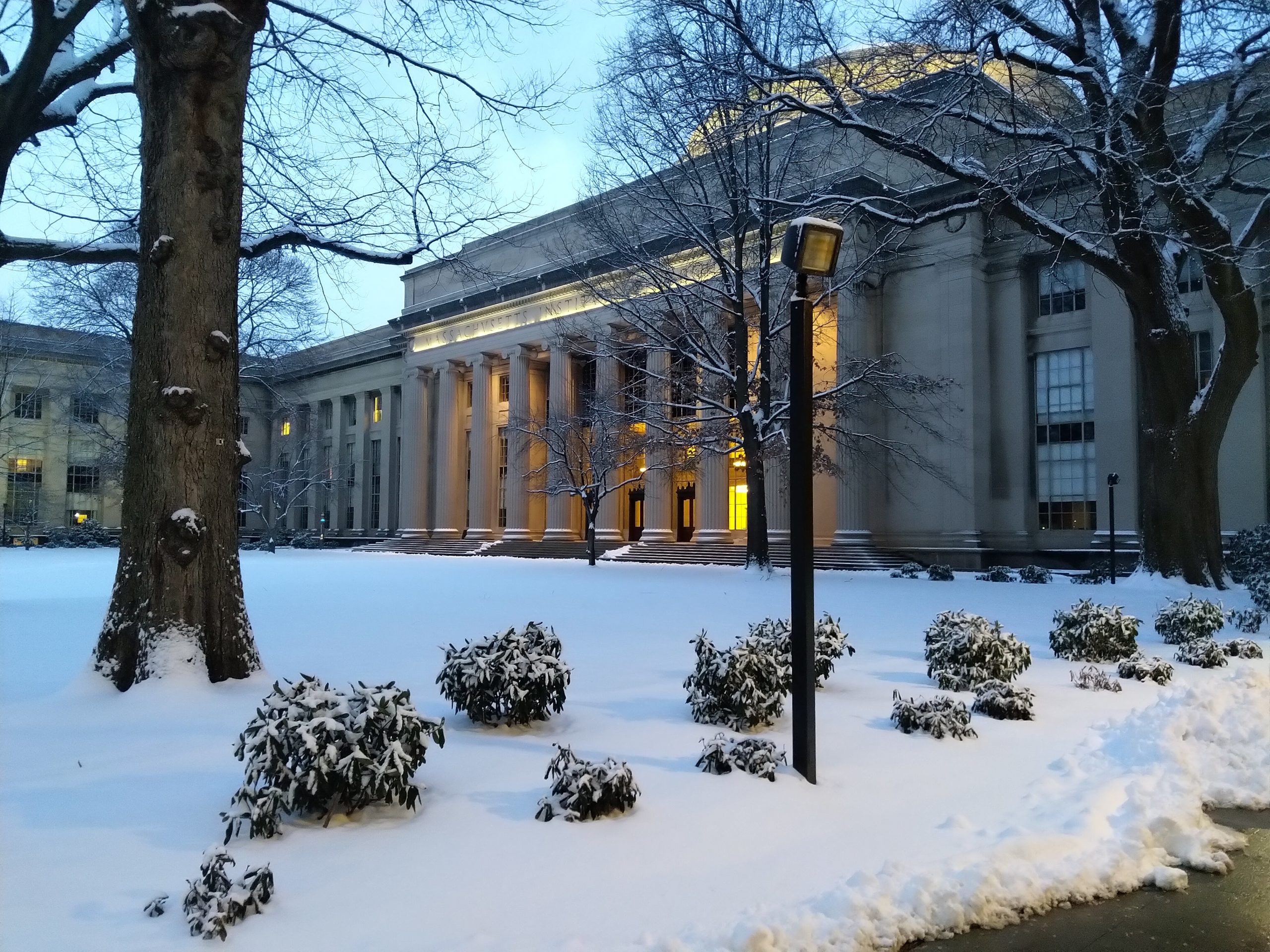
a very pretty morning
If there are two things that characterize how Galactic does puzzlehunts, based on what I’ve heard, then it’s that we really love backsolving, and that we tend to get stuck on metas.
They told me the story of the 2018 hunt. We were stuck on one of the metas, on the Hacking Island, which we needed to solve in order to get the metameta for that island, or something like that. It was unlocked at around 2 PM, and people worked on it for six hours, during which people started giving up, and during which the coin was found. Death and Mayhem, the team running the hunt, even sent two people to answer yes-or-no questions to give hints. And then when people started leaving the room for dinner,19 Anderson recounts the story slightly differently. Per him, he was “sitting in a location that blocked Brian’s view of the blackboard”, so his contribution to the meta was leaving the room. He also says that there were two separate metas in 2019 that were stuck but then solved right after he left for meals. Brian has his <a href="https://blog.vero.site/post/2018-hunt">own writeup of that hunt</a>. Brian was left alone, started staring at the puzzle, and then found the insight needed to solve the meta.
And we also got stuck on a meta this hunt, for Spaceopolis. On Friday night, we had relatively few puzzles open, with the main bottleneck being that we hadn’t solved the Spaceopolis meta, and we were stuck on it for such a long time. So I wasn’t optimistic about this meta. But it felt like we were so close to victory—we had all the pennies, and all the information, and all we needed was to put them together.
Another hour passed. We have a good way to place the coins, that we thought was really good. We couldn’t figure out what to do with it.
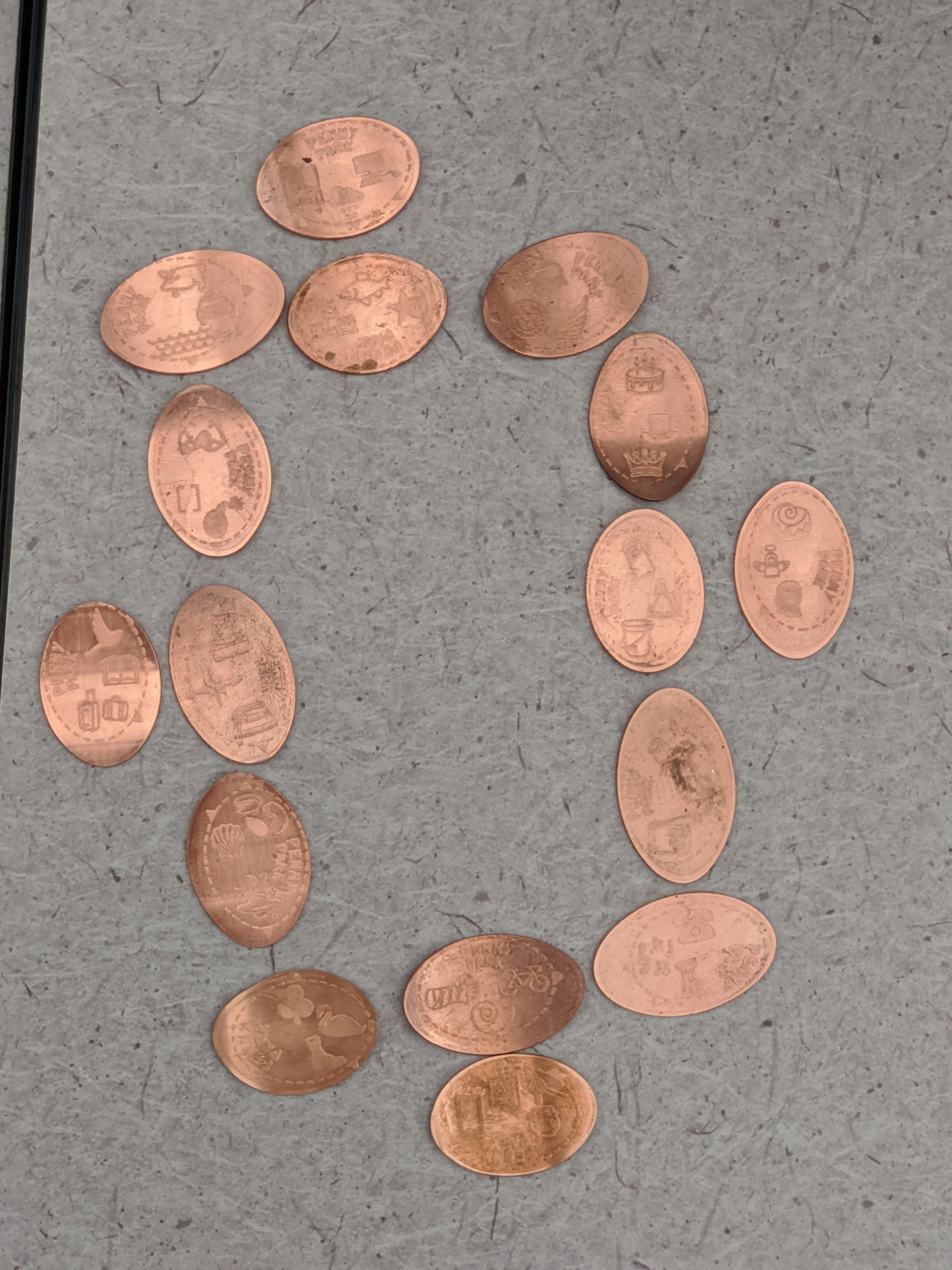
they’re arranged such that the arrows point to each other
There was one person, Anderson, who just arrived after having to solve remotely. I made the joke that if this was fiction, then Anderson’s arrival would be the cruicial piece needed to solve the puzzle, and that we’d quickly solve it after this. Someone else pointed out that it would be more thematic if someone had a character change which would lead to the solution. But it didn’t seem like tropes were going to save us now.
It’s noon. Still no email announcement. Some of the members of Left Out came to our room to watch us.
And then, and then, and then, and then—
The beginning of the end
This section contains spoilers for the Workshop metameta and Heart of the Park.
Earlier, someone pointed out that each card had three sentences. And then someone pointed out that the three sentences loosely corresponded with the pictures on the pennies. The key realization was that they did correspond, if you added a word to the pictures to make a two-word phrase. For example, the picture of the castle corresponded to the phrase a temporary structure, cluing SAND CASTLE. Or relied on it to help them navigate with star, to make STAR CHART.
We started filling them out on a spreadsheet. And then someone noticed that adjacent words differed by exactly one letter. And all of a sudden, the room was alive again—this was the idea, this was the right idea, and the whole room started filling in the phrases, and everyone was so excited.

frantically filling in the spreadsheet
The letters started falling into place. ?ORTH… maybe, was this FOR THE, or was it FOR THIS? We got SCENTI?????…, so was that SCIENTIFIC? No, is it SCENTIMENTAL, a pun? More and more letters popped out. FOR THE SCENTIMENTAL VALUE? No, that was wrong. FOR THIS CENTIMENTAL VALUE? Still wrong. More letters got changed.
And then, someone submitted it. FOR THIS CENT I MINT ALL VALUE.
And that was it. The room was full of energy. We unlocked Heart of the Park, which was the final runaround. Not a single runaround, but ten runarounds, which could be completed in parallel. We split up into teams and started doing them.
I did the Safari Adventure runaround, which I picked at random. It was a rather funny one. After identifying the painting as being next to room 2-190, which I passed by every morning during the Fall semester for one of my classes, we followed the instructions. There was, as the instructions said, a large viewing window with a river, the Charles river, and a majestic Mountain range, which was the Boston skyline.
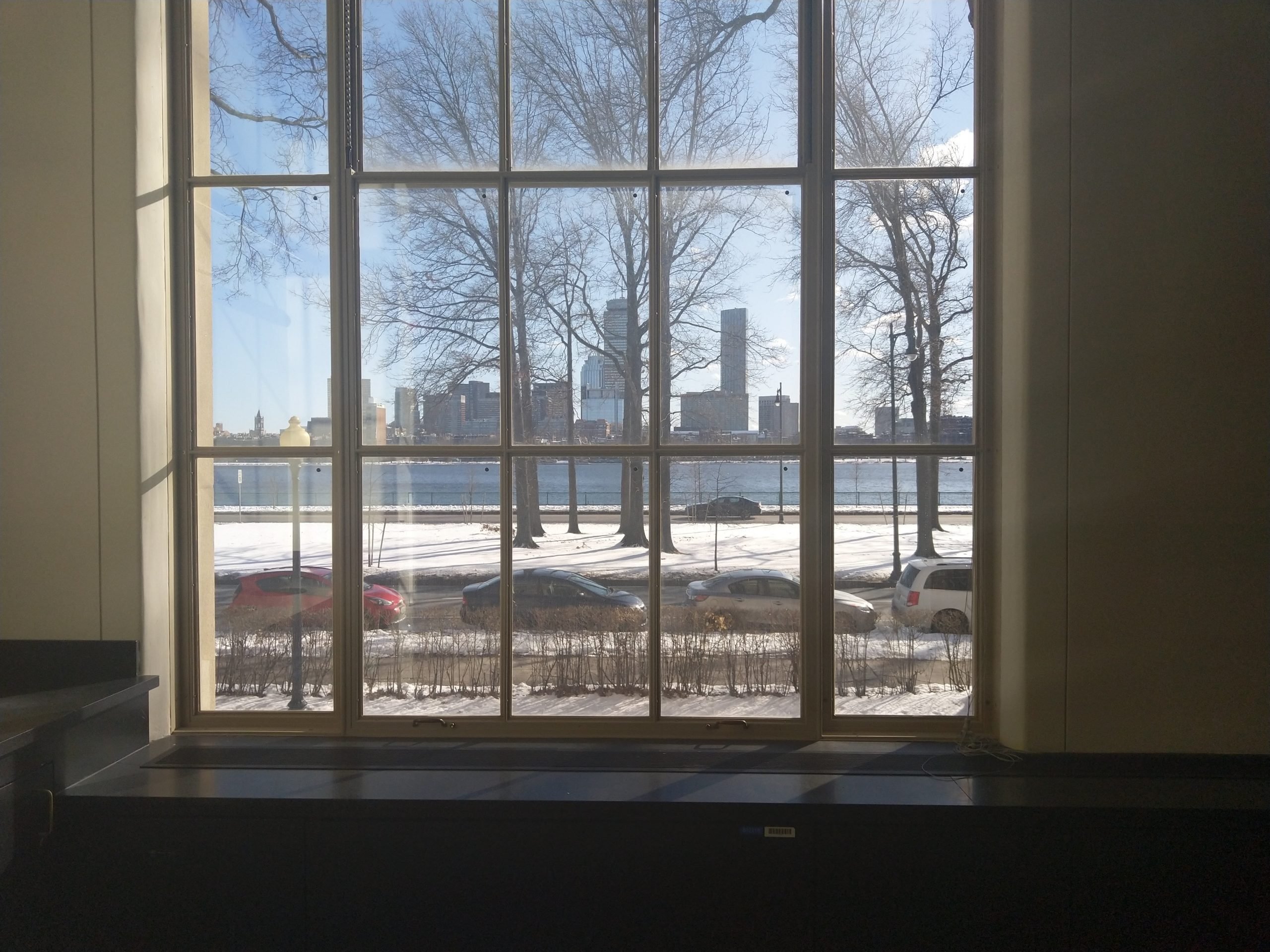
a “large viewing window”, a river, and a “mountain range”
The rest of the walkaround was more comparisons. There was a reference to a large brown Eagle, which was a sculpture outside Walker, and a Firefly, which was a lamppost. Some of them are pretty funny. If you’re on campus, then you should definitely give the runaround a try. At the end of the runaround was a sheet of paper that we used to find the answer.
We were the first team to get back to Galactic HQ and submit an answer, probably because we had one of the easier runarounds. We waited, while helping out the team solving the Wizard’s Hollow runaround, which wasn’t a physical runaround, but was a runaround somewhere. Someone eventually realized that it was a runaround on the symbols of The Alchemist sculpture, one of the more iconic MIT sculptures, and eventually we had all the answers.
The ten answers were all instructions. The Safari one was POSE YOGA, for example, while the Grand Castle one was PLAN REGICIDE. Typing in the answers gave us instructions. For Safari, we had to perform three animal-named yoga poses, and for Castle, we need to recreate our favorite fictional regicide. We were told to assemble in Lobby 10 with our collected pennies, and to get the ten performers ready for each task.
The final runaround
We had twenty minutes to prepare for the tasks. And then we went to Lobby 10, and there waiting for us were the Left Out staff. They led us down the tunnels, with Penny asking us questions at certain intersections to determine where to go, whose answers depended on the history of Penny Park.
We were eventually led into this room with a really cool looking machine, which Penny introduced to us was the Heart of the Park. She made the pun that it was her grandmother’s creation—or, you know, nana technology.
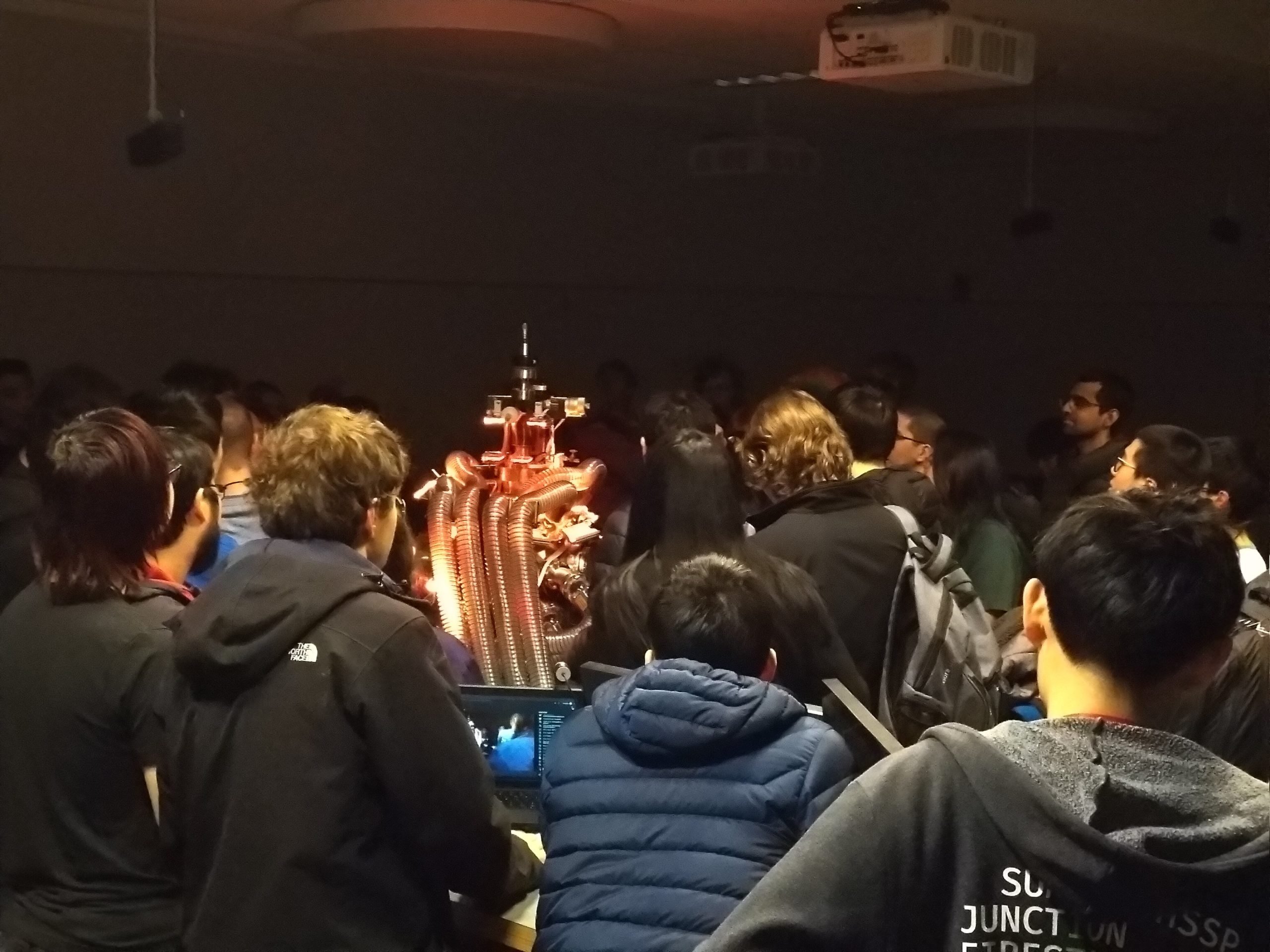
yeah there’s a lot of us
Some people fiddled with the pennies and the machine, and then we were asked to do the tasks we were assigned. So someone did yoga poses, two people enacted a scene from Macbeth, someone recited the first few lines of Jabberwocky. It was pretty good.
We were then told that the machine wasn’t working right—the parts weren’t in sync with each other. And to make them synchronize, we needed to combine the tasks together. So for example, someone did yoga poses during the scene from Macbeth. And these tasks were even funnier.
In the end, we all sat down around the machine and watched it change color. It filled the room with all these beautiful lights and sounds. And then 3 4 4 1 4 3 5 appeared on its surface, and we were all asked what it meant. It was the number of letters of each word in the phrase FOR THIS CENT I MINT ALL VALUE. We all said the phrase together, and then the cover popped open, and out came the coin.

it looks way cooler in real life
Then twelve(!) projector screens in the room rolled down, and a final history video was shown. These videos only really make sense in a series, and if you want to see them, you can look at this page and scroll down to watch the six history videos.
And that’s it. We won. We take a group picture20 Which, sadly, didn’t have everyone on Galactic because some of them were asleep. before heading back to HQ to clean up.
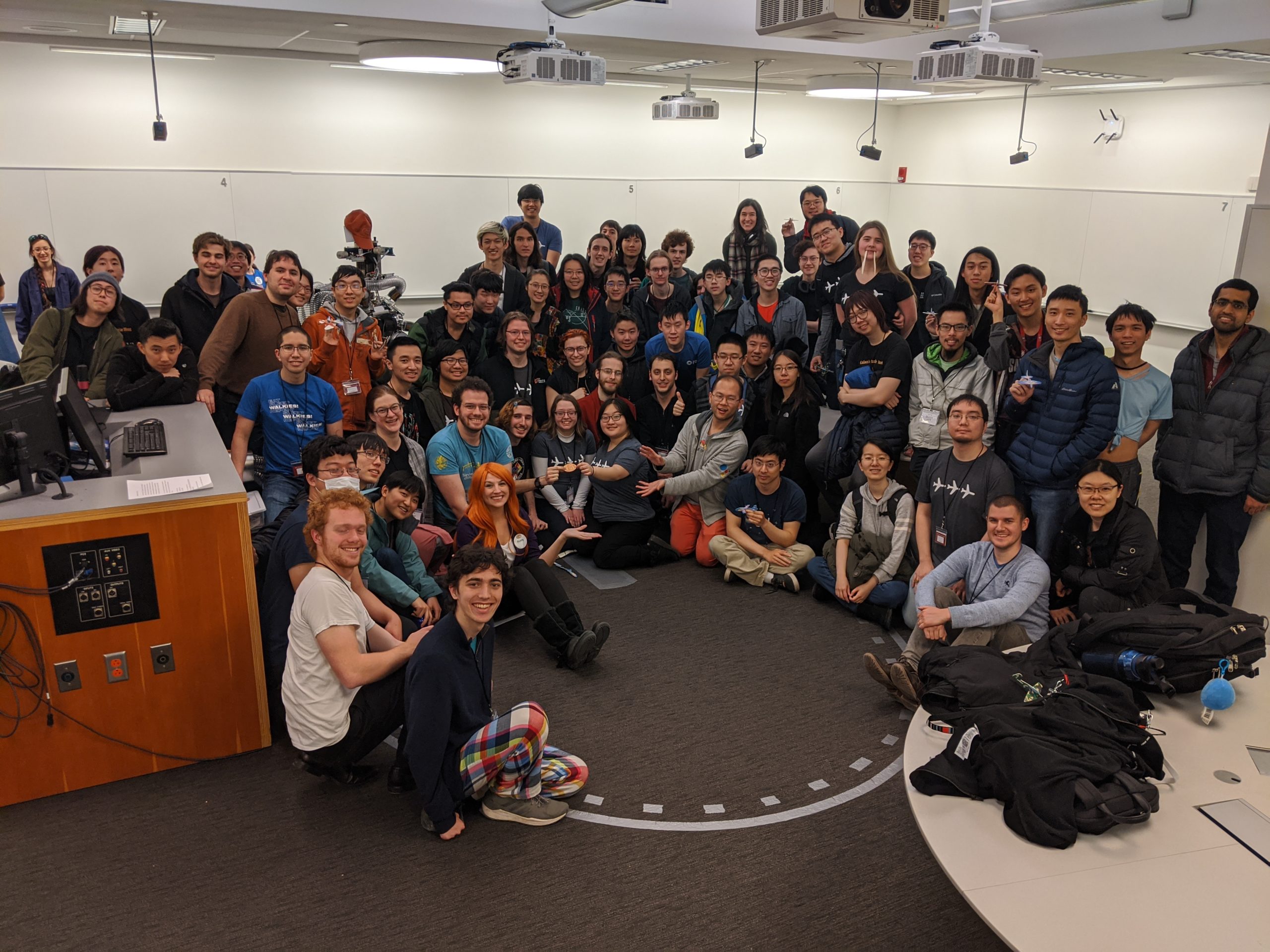
this is like, what, 80% of the team? photo from left out
Help me because I don’t know
Wrapup
That night, people chilled around Floor Pi, and I got to play more board games. On Monday noon was the wrapup. You can watch a video of it here:
We headed back to HQ, where Charles gave each of us commemorative coins, each replicas of the actual coin:
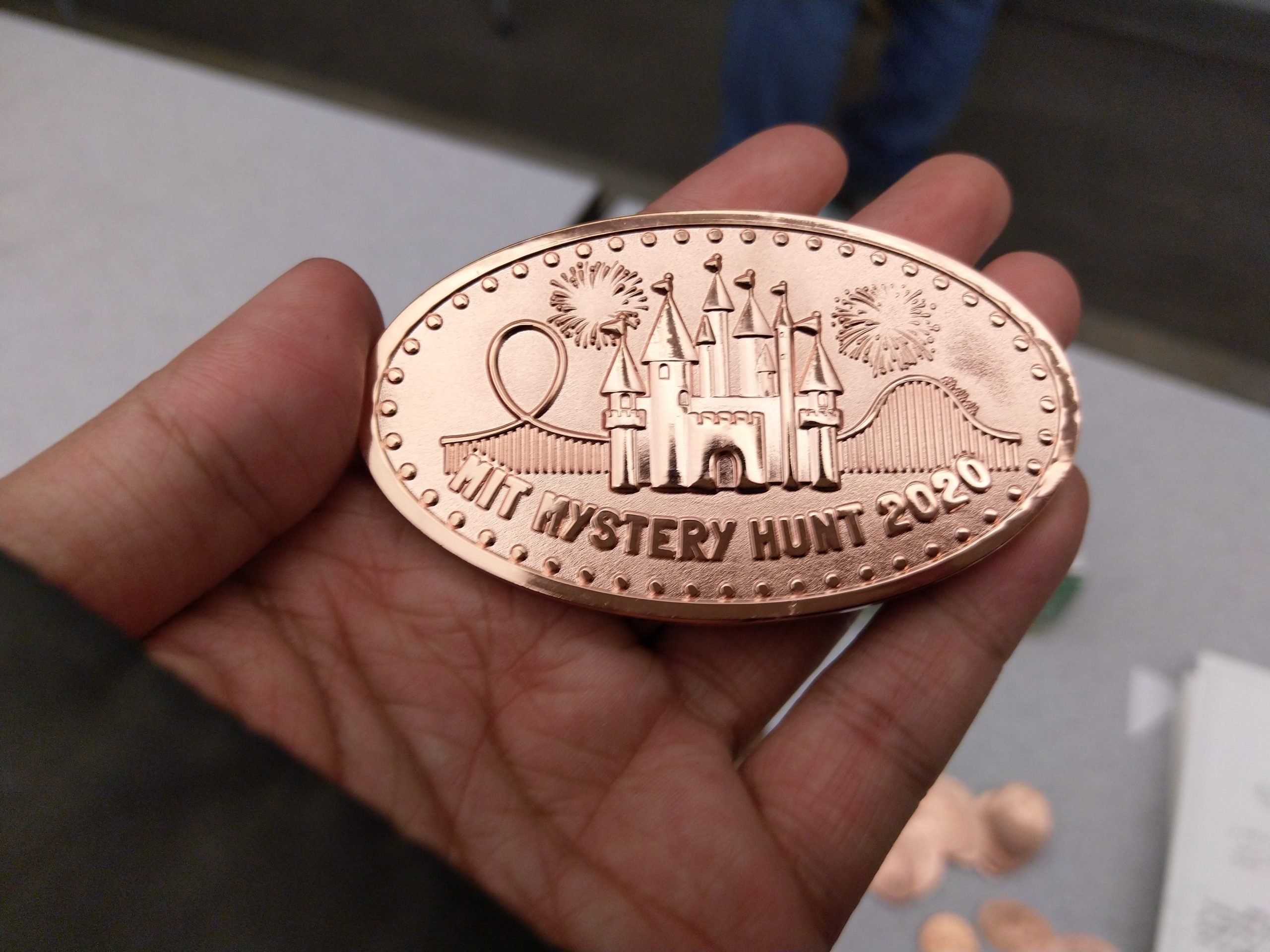
the coin! the coin!!
There was discussion about whether Galactic Puzzle Hunt, a puzzlehunt that Galactic helps run, will happen this year. It was eventually decided that it wouldn’t. A new Discord server was made for people who wanted to help run the hunt, and another Discord server was made for people who wanted to hunt. I decided to join the former.
People split off to have lunch. I went to eat at Flour Bakery + Cafe, a restaurant that holds a place in Floor Pi culture. That afternoon, we played some Jackbox games. That evening, we played more board games. People started leaving that night. By Wednesday, pretty much everyone who flew in for Hunt left.
It’s been two weeks,21 And so much has happened in these two weeks, that my mind asks: <em>only</em> two weeks? but I still have a lot of feelings about Hunt. It feels weird, in a sense, to be part of a big group. It reminds me of how I felt when I contributed to Splash. Small enough that it’s hard to notice, or to feel like I’ve done anything of worth, while being big enough that it felt like I actually did something, but I’m not sure whether someone could have replaced me.
And like Splash, I felt a void in my life for the next week or so. The high-energy buzz that was Hunt was now over. I directed some of that energy into thinking about next year’s Hunt, but it wasn’t enough to cover up the lack that I felt. Days after the Hunt ended, I found myself still talking about puzzles.
I remember one conversation I had, talking to someone on Floor Pi, when I jokingly compared my life to a puzzle, and that I needed help with extraction. After I thought about it for a little, it made a lot of sense with how I felt about my life in general. I had already collected a lot of the data I needed, but I don’t know what to do with it. I don’t know how to piece everything I know about myself to figure out the next step.
I know what I enjoy, and I find myself doing these things, and it’s great. It feels like I’ve put the pieces of the jigsaw together, or that I’ve solved the crossword, or that I’ve assembled whatever I need to assemble. But now I find myself asking what happens next? Now that I know what I enjoy, and that I’m starting to get an idea of what I want with my life, what do I do with this information? And is a puzzle really fun if you’re just constantly stuck?
Sometimes I find myself wishing that I could mark myself as stuck on extraction, and that someone would come by, look at all the info I’ve gathered so far, and just give that crucial insight needed to extract the answer. And you know, it doesn’t even have to be one person. Maybe if multiple people come by, and all give me their own ideas, then maybe I can come up with the solution myself. And then I’d solve this puzzle, and I’d do another puzzle, and another, and maybe when I have enough answers I can start working on the metapuzzle.
Because puzzles are more fun when you do them with other people, right?
A puzzle
Of course, being a blog post about puzzles, I couldn’t resist embedding a puzzle in this blog post too. You’ll find a six-letter sound if you read the first thing that comes to mind, and you’ll find another six-letter sound if you read the last. The two-word answer belongs between these two six-letter sounds.
The first word of the two-word answer has 8 letters, and the second word has 12. This blog post is all you need; you don’t need to solve any of the linked puzzles or anything to find the answer. Happy puzzling!
Thanks to ✈✈✈ Galactic Trendsetters ✈✈✈ for testsolving the puzzle, reading and giving comments on drafts of this post, and for making my Hunt experience great. And thanks to Left Out for making this year’s Hunt possible in the first place.
- I’m going to break blog convention here and use only the first name of everyone I mention, because I don’t really know everyone’s last initials or graduation years. back to text ↑
- When discussing puzzles, we write answers in capital letters to indicate it's an answer. back to text ↑
- Exercise left for the reader. As a hint, read the first letters. It’s often a good idea to read the first letters! back to text ↑
- This entire section is not very well-researched, so read everything with an “I know of”. Also, the easiest way to learn something on the internet is to be wrong and wait for someone to correct you. Please correct me. back to text ↑
- I don’t really know, and none of the people I asked knew either. back to text ↑
- I think before this year, most people who hunted from Next were associated with Super Team Awesome, though I may be wrong. It may even still be the case this year. back to text ↑
- Wayne, who read a draft, complained: “Putzazoo? I thought we called them Tetaputz.” back to text ↑
- Each of these are names of floors. Tetazoo is Third East, Putz is Second West, and First East is… First East… back to text ↑
- Lillian and Cesium point out that this team split into the Random team and Hunches in Bunches. back to text ↑
- Brian tells me that they’re a team that originated from Reddit, whose original name was Test Solution, Please Ignore, a reference to test post please ignore. They merged with Aviation Laws to become Test Solution, Bees Ignore. back to text ↑
- Danny tells me they’re composed of Stanford members who’ve been around the Bay Area puzzle scene for several years now. back to text ↑
- Or, this year, The Team Formerly Known as the Team Formerly Known as the Team to Be Named Later. back to text ↑
- While everyone spells the first plane noise as whoosh, there is considerable controversy as to how the other plane noise should be spelled. And I think this is the correct way to spell it. back to text ↑
- Yeah, I don’t get this part either. back to text ↑
- This used to say board game, and then Brian disputed this, so I checked BoardGameGeek standards and realized logic puzzle would be a better phrase. back to text ↑
- Well, I hope I contributed, rather than, you know, anti-contributed. back to text ↑
- Always a good idea. back to text ↑
- There are people on Galactic who really like working on metas. back to text ↑
- Anderson recounts the story slightly differently. Per him, he was “sitting in a location that blocked Brian’s view of the blackboard”, so his contribution to the meta was leaving the room. He also says that there were two separate metas in 2019 that were stuck but then solved right after he left for meals. Brian has his own writeup of that hunt. back to text ↑
- Which, sadly, didn’t have everyone on Galactic because some of them were asleep. back to text ↑
- And so much has happened in these two weeks, that my mind asks: only two weeks? back to text ↑